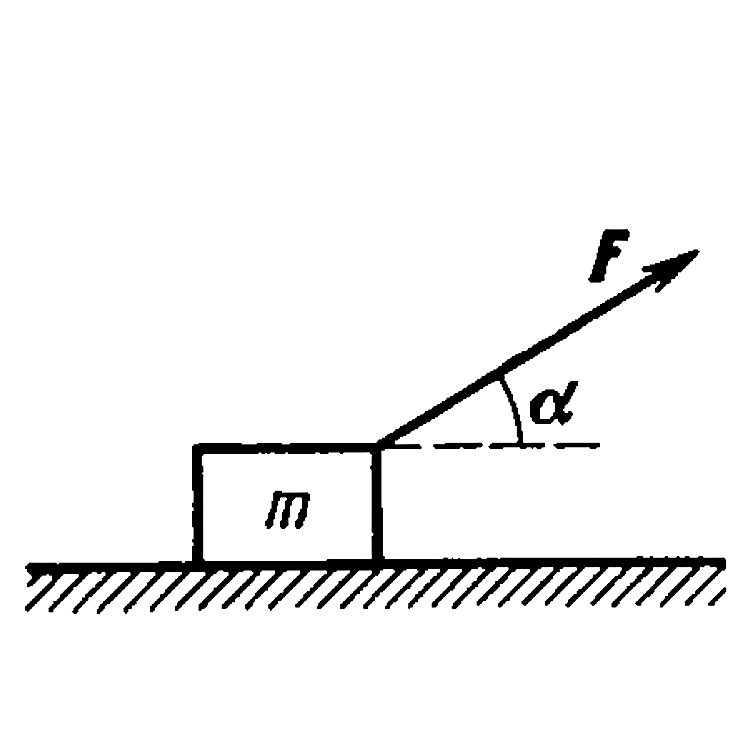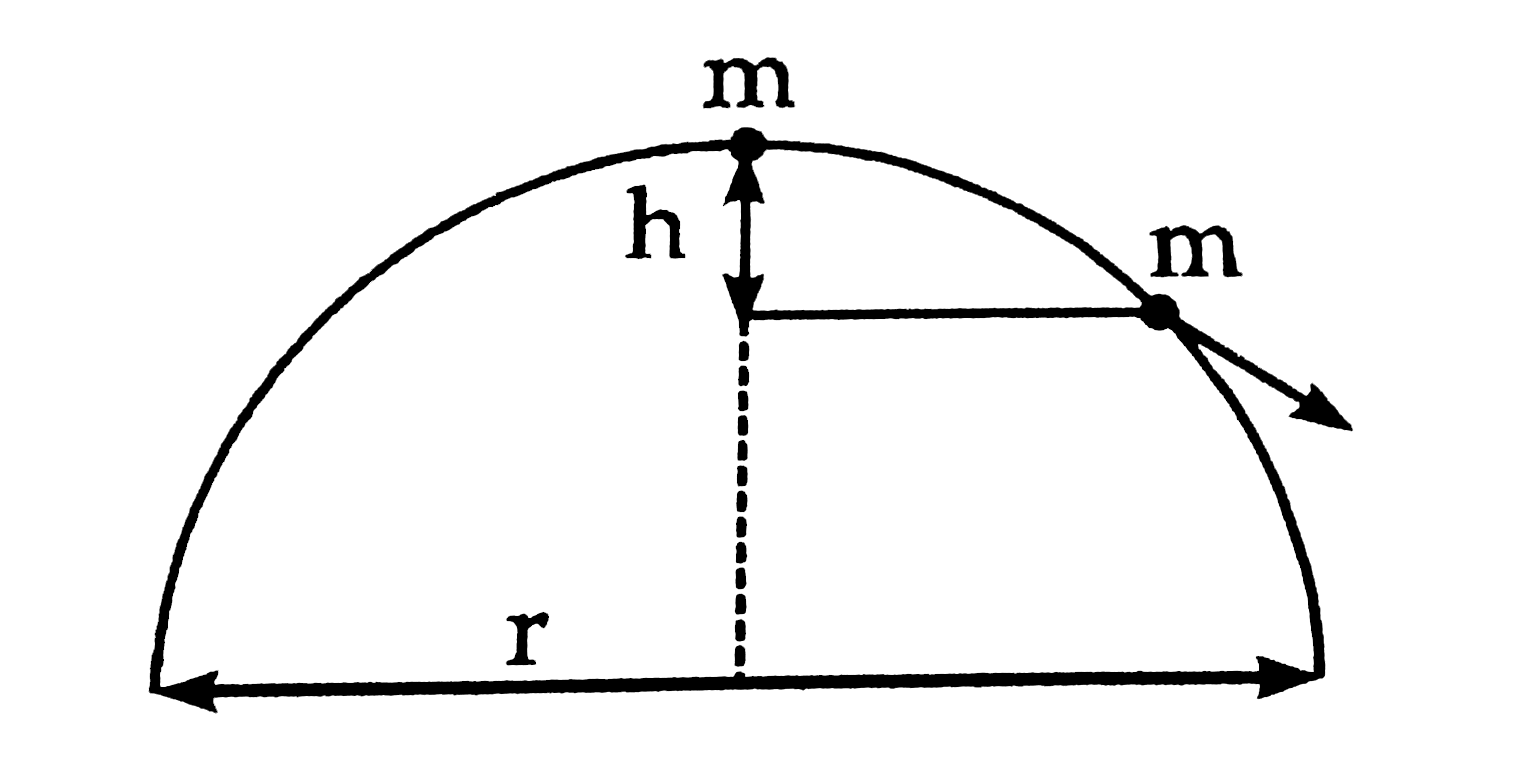A small body A starts sliding from the height h down an inclined groove passing into a half-circle of radius h/2 (figure).

Assuming the friction to be negligible, find the velocity of the body at the highest point of its trajectory (after breaking off the groove).
To complete a smooth vertical track of radius R, the minimum height at which a particle starts, must be equal to 52R (one can proved it from energy conservation). Thus in our problem body could not reach the upper most point of the vertical track of radius R/2. Let the particle A leave the track at some point O with speed v (figure). Now from energy conservation for the body A in the field of gravity:
mg[h−h2(1+sinθ)]=12mv2
or, v2=gh(1−sinθ) (1)
From Newton's second law for the particle at the point O., Fn=mwn,
N+mgsinθ=mv2(h/2)
But, at the point O the normal reaction N=0
So, v2=gh2sinθ (2)
From (3) and (4), sinθ=23 and v=√gh3
After leaving the track at O, the particle A comes in air and further goes up and at maximum height of it's trajectory in air, it's velocity (say →v) becomes horizontal (figure). Hence, the sought velocity of A at this point.
v′=vcos(90−θ)=vsinθ=23√gh3

Topper's Solved these Questions
- PHYSICAL FUNDAMENTALS OF MECHANICSBook:IE IRODOV, LA SENA & SS KROTOVChapter:PHYSICAL FUNDAMENTALS OF MECHANICSExercise:Universal Gravitation
Explore 34 Videos
- PHYSICAL FUNDAMENTALS OF MECHANICSBook:IE IRODOV, LA SENA & SS KROTOVChapter:PHYSICAL FUNDAMENTALS OF MECHANICSExercise:Dynamics Of A Solid Body
Explore 56 Videos
- PHYSICAL FUNDAMENTALS OF MECHANICSBook:IE IRODOV, LA SENA & SS KROTOVChapter:PHYSICAL FUNDAMENTALS OF MECHANICSExercise:The Fundamental Equation Of Dynamics
Explore 59 Videos
- OSCILLATIONS AND WAVESBook:IE IRODOV, LA SENA & SS KROTOVChapter:OSCILLATIONS AND WAVESExercise:Electromagnetic Waves, Radiation
Explore 36 Videos
- THERMODYNAMICS AND MOLECULAR PHYSICSBook:IE IRODOV, LA SENA & SS KROTOVChapter:THERMODYNAMICS AND MOLECULAR PHYSICSExercise:Transport Phenomena
Explore 38 Videos
Similar Questions
A small body A starts sliding off the top of a smooth sphere of radius R. Find the angle θ (figure) corresponding to the point at which the body breaks off the sphere, as well as the break-off velocity of the body.

View SolutionAt the moment t=0 the force F=at is applied to a small body of mass m resting on a smooth horizontal plane (a is constant).
The permanent direction of this force forms an angle α with the horizontal (figure). Find:
(a) the velocity of the body at the moment of its breaking off the plane,
(b) the distance traversed by the body up to this moment.

View Solution
Knowledge Check
A body A is dropped from a height h above the ground. At the same time another body B (at a horizontal' distance d from the line of fall of A) is fired from the ground at an angle α to the horizontal. If the two bodies collide at the highest point of the trajectory of B the angle of projection is given by
 Aα=tan−1(dh)Bα=sin−1(hd)Cα=tan−1(hd)Dα=cos−1(hd)
Aα=tan−1(dh)Bα=sin−1(hd)Cα=tan−1(hd)Dα=cos−1(hd)A body of mass m is released from a height h on a smooth inclined plane that is shown in the figure. The following can be true about the velocity of the block knowing that the wedge is fixed.
 .Av is highest when it just touches the springBv is highest when it compresses the spring by some amountCv is highest when the spring comes back to natural positionDv is highest at the maximum compression
.Av is highest when it just touches the springBv is highest when it compresses the spring by some amountCv is highest when the spring comes back to natural positionDv is highest at the maximum compressionA body slides down a fixed curved track that is one quadrant of a circle of radius R, as in the figure. If there is no friction and the body starts from rest, its speed at the bottom of the track is
A5gRB√5gRC√2gRD√gR
A small body of mass m slide without friction from the top of a hemispherical cup of radius r as shown in figure. If leaves the surface to the cup at vertial distance h below the highest point then

View SolutionA body is thrown from the surface of the Earth at an angle α to the horizontal with the initial velocity v0. Assuming the air drag to be negligible, find:
(a) the time of motion,
(b) the maximum height of ascent and the horizontal range, at what value of the angle α they will be equal to each other,
(c) the equation of trajectory y(x), where y and x are displacements of the body along the vertical and the horizontal respectively,
(d) the curvature radii of trajectory at its initial point and at its peak.
View SolutionIn the system shown in figure the masses of the bodies are known to be m1 and m2, the coefficient of friction between the body m1 and the horizontal plane is equal to k, and a pulley of mass m is assumed to be a uniform disc. The thread does not slip over the pulley. At the moment t=0 the body m2 starts descending. Assuming the mass of the thread and the friction in the axle of the pulley to be negligible, find the work performed by the friction forces acting on the body m1 over the first t seconds after the beginning of motion.

View SolutionA small sphereical ball is released from a point at a height h on a rough track shown in figure. Assuming that it dow not slip anywhere, find its linear speed when it rolls on the horizontal part of the track.

View SolutionAt the equator a stationary (relative to the Earth) body falls down from the height h=500m. Assuming the air drag to be negligible, find how much off the vertical, and in what direction, the body will deviate when it hits the ground.
View Solution

